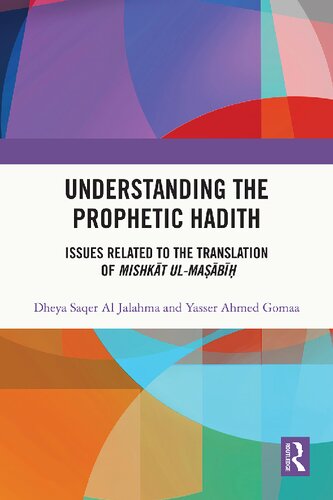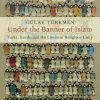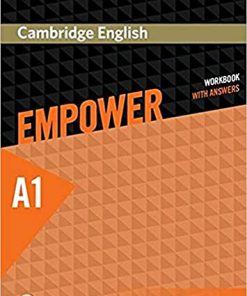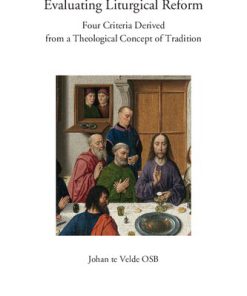Understanding the Prophetic Hadith Issues Related to the Translation of Mishkāt ul Maṣābīḥ 1st Edition by Dheya Saqer Al Jalahma, Yasser Ahmed Gomaa ISBN 9781000870084 1000870081
$50.00 Original price was: $50.00.$25.00Current price is: $25.00.
Understanding the Prophetic Hadith Issues Related to the Translation of Mishkāt ul Maṣābīḥ 1st Edition by Dheya Saqer Al Jalahma, Yasser Ahmed Gomaa – Ebook PDF Instant Download/Delivery: 9781000870084 ,1000870081
Full download Understanding the Prophetic Hadith Issues Related to the Translation of Mishkāt ul Maṣābīḥ 1st Edition after payment

Product details:
ISBN 10: 1000870081
ISBN 13: 9781000870084
Author: Dheya Saqer Al Jalahma, Yasser Ahmed Gomaa
Understanding the Prophetic Hadith Issues Related to the Translation of Mishkāt ul Maṣābīḥ 1st Edition Table of contents:
1 Understanding the Hadith: Issues Related to the Hadith and Its Translation
1.1 Introduction
1.2 The Definition of Hadith and Sunnah
1.2.1 Hadith Nabawi and Hadith Qudsī
1.3 The Significance of the Hadith
1.4 Conceptualizing the Translation of the Hadith in Islam
1.5 Conveying the Sense of the Hadith
1.6 Conclusion
Notes
2 The Relevance of Vermeer’s (1978) Skopos Theory to the Translation of the Hadith
2.1 Introduction
2.2 Historical Overview of Bible Translation
2.3 Nida’s Theory of Bible Translation
2.4 Formal and Dynamic Equivalence
2.5 Relevance Theory
2.6 Functionalist Approaches: Skopos Theory
2.7 Skopos Rules
2.8 Nord’s Concept of Loyalty
2.9 Skopos Theory in Bible Translation
2.10 Skopos Theory and Loyalty: Bridging Cultural Gaps in Bible Translation
2.11 Conclusion
Notes
3 Translation of Mishkāt ul-Maṣābīḥ into English: Theoretical and Methodological Issues
3.1 Introduction
3.2 Important Scholars of the Hadith and Their Books
3.2.1 The Book of Hadith Maṣābīḥ al-Sunnah
3.2.2 The Aim of Maṣabīḥ al-Sunnah
3.2.3 The Compilation of Mishkāt al-Maṣābiḥ
3.2.4 Al-Tabrīzī’s Modification of Maṣabīḥ al-Sunnah
3.2.5 The Importance of Mishkāt ul-Maṣābīḥ
3.2.6 Arabic Commentaries on Mishkāt ul-Maṣābīḥ
3.3 The English Translations of Mishkāt ul-Maṣābīḥ
3.3.1 The English Translation of Mishkāt ul-Maṣābīḥ by Fazlul Karim
3.3.2 The Skopos of Fazlul Karim’s Translation
3.3.3 The English Translation of Mishkāt ul-Maṣābīḥ by James Robson
3.3.4 The Skopos of Robson’s (1963) Translation
3.3.5 Skopos Theory and Loyalty in Mishkāt ul-Maṣābīḥ’s Translation
3.4 Categories of Selected Hadiths
3.5 Translation Strategies of Leppihalme (1998)
3.5.1 Strategies Used for the Translation of Culture-Bound Terms
3.5.1.1 Strategy 1: Retention of Culture-Bound Terms
3.5.1.2 Strategy 2: Replacement of the Term by a Target Language Term
3.5.1.3 Strategy 3: Omission of the Term
3.5.2 Strategies Used for the Translation of Culture-Bound Phrases
3.5.2.1 Strategy 1: Use of a Standard Translation
3.5.2.2 Strategy 2: Literal Translation
3.5.2.3 Strategy 3: Extra Guidance Added in the Text
3.5.2.4 Strategy 4: Overtly Given Information
3.5.2.5 Strategy 5: Internal Marking for a Culture-Specific Phrase
3.5.2.6 Strategy 6: Reduction to Sense by Rephrasal
3.5.2.7 Strategy 7: Omission of the Culture-Specific Phrase
3.6 “General,” “Islamic-Legal” and “Regional” Meanings of Arabic Terms
3.7 Criteria for Selecting the Hadiths
3.8 Criteria for Selecting the Three Categories
3.9 Methodology for Analysis
3.9.1 Analyzing Loyalty to Al-Qari’s (1599) Commentary Book
3.9.2 Analyzing the Meaning of Arabic Terms and Expressions
3.9.3 Analysis Procedures
3.10 Additional Sources and References
3.11 Conclusion
Notes
4 The Translation of “Islamic-Legal Terms” and “Metaphors” Related to Women in Fazlul Karim’s (1938) and Robson’s (1963) Versions of Mishkāt ul-Maṣābīḥ
4.1 Introduction
4.2 The Status of Women in Islam
4.3 The Translation of Societal Roles and Terms Related to Women in Religious Texts
4.4 Arabic Terms and Their Meanings across Centuries: Language Differentiation
4.5 Analysis of the Translation of Islamic-Legal Terms for Women
4.5.1 ayyim أَيِّمُ
4.5.2 thayyib ثَّيِّبُ
4.5.3 mūmisah مُومِسَة
4.5.4 al-walīdah الوليدةُ
4.5.5 ḥiyyad حُيَّضُ (plural of ḥāʾiḍ)
4.5.6 jāriyah جارِيةً
4.6 Analysis of Fazlul Karim’s (1938) and Robson’s (1963) Translations of Metaphors for Women
4.6.1 ẓaʿīnah ظَّعِينَة
4.6.2 matāʿ مَتَاعِ
4.6.3 dhawāt al-khudūrذَوَاتِ الخُدُورِ
4.6.4 ʿawrah عَوْرَةٌ
4.6.5 shaqāʾiq al-rijāl شقائقُ الرِّجالِ
4.6.6 al-qawārīr الْقَوَارِير
4.7 Conclusion
Notes
5 The Translation of Formulaic Expressions in Fazlul Karim’s (1938) and Robson’s (1963) Versions of Mishkāt ul-Maṣābīḥ
5.1 Introduction
5.2 Defining Formulaic Expressions
5.3 Formulaic Expressions in the Arabic Language
5.4 The Translation of Formulaic Expressions
5.5 Analysis of the Translation of Formulaic Expressions in Mishkāt ul-Maṣābīḥ
5.5.1 wayḥak ويْحَكَ
5.5.2 taribat yadāh ترِبتْ يداهُ
5.5.3 taribat yadāk تَرِبَتْ يَداكَ
5.5.4 dhāt kabid raṭibah ٌذاتِ كَبِدٍ رَطْبةٍ أجر
5.5.5 al-yad al-ʿulyā khair min al-yad al-suflā اليَد العُليا خيرٌ من اليَدِ السُّفلى
5.5.6 shadda miʾzarah شدَّ مِئزَرَهُ
5.5.7 (a) faḥthu f ī afwāhihinn al-turāb فَاحْثُ في أفْوَاهِهِنَّ مِنَ التُّرَابِ and (b) arghama allāh anfak أرْغَمَ اللَّهُ أنْفَكَ
5.5.8 raghima anf rajul رَغِمَ أنفُ رجلٍ
5.5.9 (a) yarḥamuk allāh يَرْحَمُكَ اللَّهُ, (b) wā thakla ummayāh واثُكْلَ أُمِّيَاهْ and (c) bi abi huwa wa ummī بِأَبِي هو وأُمِّي
5.5.10 fidāka abī wa ummī فِداكَ أبي وأمِّي
5.5.11 ablī wa akhliqī أبْلِي وأَخْلِقِي
5.5.12 ʿuḍū ʿalayhā bil nawājidh عَضُّوا عَلَيْهَا بِالنَّوَاجِذِ
5.6 Conclusion
Notes
6 The Translation of Reported Nonverbal Behavior in Fazlul Karim’s (1938) and Robson’s (1963) Versions of Mishkāt ul-Maṣābīḥ
6.1 Introduction
6.2 The Importance of Nonverbal Behavior in Communication
6.3 Nord’s (2014) Skopos Approach to the Translation of Nonverbal Behavior
6.4 Analysis of the Translation of Reported Nonverbal Behavior
6.4.1 Leaning the Knees against the Other Person and Placing the Hand on the Thighs
6.4.2 Striking a Person on the Shoulder
6.4.3 Reclining on a Couch
6.4.4 Women Depart the Mosque before Men
6.4.5 Intertwine Fingers in Prayer
6.4.6 Facing the Corner of a Door
6.4.7 (a) Tapping on an Orphan’s Head and (b) Putting Two Fingers Together
6.4.8 (a) The Angry Look and (b) Striking the Hands on the Thighs
6.4.9 The act of Giving Charity: Moving the Hand in the Four Directions
6.4.10 (A) Hiding Behind Each Other and (B) Making a Sign with the Hand
6.4.11 Carrying Um Khalid
6.4.12 Going Alone with a Woman into a Lane
6.4.13 (a) Turning the Face Away and (b) Pointing to the Face and Hand
6.5 Conclusion
Notes
Conclusion
References
Bible Translations
Appendix: Transliteration Symbols Used in the Book
Consonants
Vowels
Long Vowels
Doubled
Diphthongs
Index
People also search for Understanding the Prophetic Hadith Issues Related to the Translation of Mishkāt ul Maṣābīḥ 1st Edition:
understanding the prophetic
understanding hadith
understanding prophetic ministry pdf
the hadith reports
how is the hadith related to the sunnah
Tags: Dheya Saqer Al Jalahma, Yasser Ahmed Gomaa, Prophetic Hadith Issues, Mishkāt ul Maṣābīḥ
You may also like…
Computers - Other
Technique - Electronics
Politics & Philosophy
Politics & Philosophy - Anthropology
Housekeeping & Leisure - Games: Chess
Housekeeping & Leisure - Games: Chess
Languages - English as a Foreign Language & Reference
English Grammar Exercises with answers Part 4 Your quest towards C2 1st Edition Daniel B. Smith
Computers - Other
TI-84 Plus CE Graphing Calculator For Dummies, 3rd Edition Jeff Mccalla











